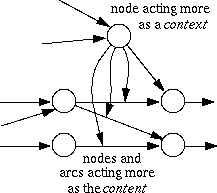
7. A Bottom-up Investigation of Internal Context in an Artificial Agent
The network is designed so that it can learn the structures of directed arcs described in [9]. It is designed to be as free from assumptions about the structure of the contexts as possible - thus it is ideal for this kind of investigation where the purpose is to investigate what the appropriate assumptions are in a particular environment. Broadly speaking, a context is represented by one (or more) nodes that develop a role of `switching' sets of associations, whilst other nodes represent facts about the environment. There is, of course, no hard and fast distinction between context nodes and other nodes but more that in some circumstances some nodes act more as contexts and others act more as the content of the model in context. The difference is illustrated in figure 5.

Figure 5. Nodes acting as contexts and other nodes
If the structure of the network allows it, there is nothing in the algorithm that prevents the network: learning in a context-free way; having contexts imply other contexts, developing hierarchies of contexts, having nodes acting as contexts in some situations and not in others etc. It can be interpreted as implementing both inferential and pattern recognition processes: whether a node is fired is a matter of pattern recognition as a result of the learning done by the network, but the resulting firable arcs can be analysed in terms of (possibly context-dependent) implications about its environment.
The Pragmatic Roots of Context - Bruce Edmonds - 31 MAR 99
[Next] [Previous] [Up] [Top] [Contents]
Generated with CERN WebMaker